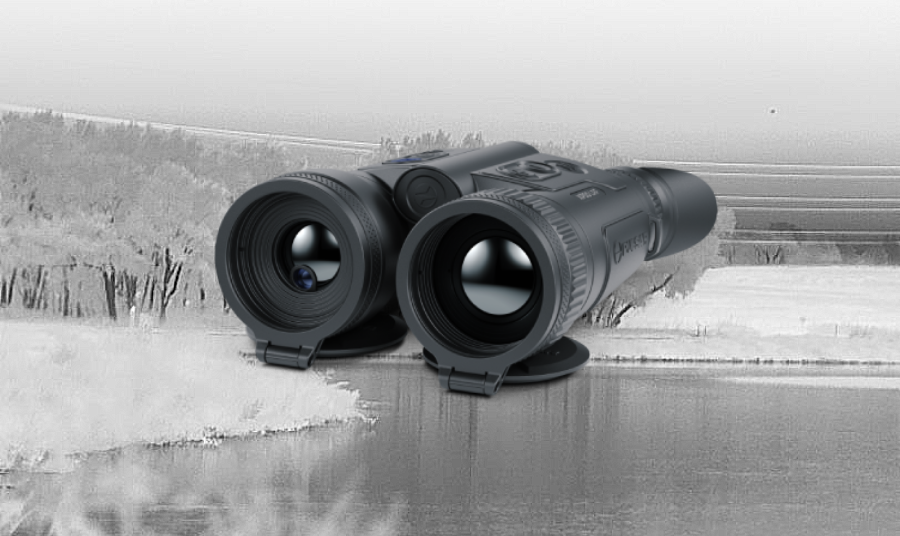I had long wondered what practical applications thermal imaging might have outside of the hunting world. The most obvious purpose for high quality thermal optics, in my mind is exploration. In my youth, I was fond of hiking in the rainforests of my home country, but as the curtain of night would fall and the once-still greenery of the forest would begin to come alive with all manner of howls and chirps, human hikers would have to leave before darkness could completely overtake them and leave them stranded in the woods. Now, I finally had the opportunity to see what the woods were like when they were truly awake.
Pulsar’s Merger LRF XP50 Thermal Binoculars were perfect for some late-night wildlife observation. I had never used them before, but my expectations were high due to Pulsar’s name alone. Taking the Merger out of the box, I was pleasantly surprised to know I wouldn’t have to waste time charging its batteries for first time use. The Merger’s APS 3 battery boasted ten hours of continuous operation with both batteries, thanks in part to battery saving features like its proximity sensor, which puts the unit to sleep as soon as it senses the user no longer has the device near his face.
Knowing I wouldn’t need to worry about the device dying mid-expedition, I made my way over to Oak Point Park and Nature Preserve in Plano, Texas. With 800 acres of well-preserved forest located in the middle of the city, Oak Point is Plano’s largest park. It was also one of the few parks that closed at 11pm, making it perfect for nighttime animal observation. Oak Point promised rattlesnakes, bobcats, coyotes, owls and other creatures of the night. I was excited to put the Merger to the test.
When I arrived at Oak Point, there was hardly a soul around. The only light sources came from the streetlamps in the parking lot and bungalows. Beyond the cement walkways, the lake and forest trails beyond were completely engulfed in darkness. The last few late night hikers who remained were making their way out of the park, leaving no one to disturb the animals. After giving the manual a brief review, I turned on the Merger and let it lead me through the night. Almost immediately I spotted my first animal.
Visible only through the Merger, a nine banded armadillo foraged for food near the riverbank. It dug away at the soil, searching for insects with its tiny claws, oblivious to the fact I was only a few feet away.

The Merger’s high definition 640x480 sensor displayed the little creature with surprising sharpness. As far as I could tell, there was no lag between the creature’s actions in real time and what the Merger was showing through its display. The device’s automatic Non-uniformity Correction (NUC) calibration also helped reduce any image flaws like vertical bars and unwanted specks from IR radiation.
Continuing down the trail, I tested the Merger’s laser range finder as I went on various trees and structures in the distance. Considering the unit was handheld and not mounted on a tripod for stability, the readings were consistent in both “manual” rangefinding mode and scan mode. In “manual” rangefinding, the unit measures the distance of any object within its crosshairs at the push of a button, while scan mode emits a constant laser, automatically feeding the user data on the distance and angle of whatever the unit is pointing at.
The Merger’s eight different color palettes also came in handy while observing wildlife. A bird’s feathers offer terrific insulation for the animal and are more difficult to detect on thermal vision in black hot or white hot modes. In rainbow mode, however, I managed to capture a great egret as it finished its midnight fishing trip and flew off into the darkness.

The Merger’s high shutter speed manages to capture this photo with minimal blur and distortion. While the egret’s feathers camouflage the bird itself, its IR radiation reflects red heat off the lake’s water. While thermal vision isn’t the best for fishing, it’s better than plain night vision for wildlife observation on land.
The many features of these high-tech thermal binoculars don’t just end with its photo capabilities. Using the Stream Vision 2 App with the device can be a nuanced experience which users may find to be quite convenient when they understand it. First time Pulsar owners might be confused about how to “connect their phones to Wi-Fi” in the middle of the wilderness. However, Wi-Fi in the case of Stream Vision 2 does not mean “Internet.” The Merger functions as its own offline hotspot which a phone can connect. Once the phone is connected to the device’s hotspot, to both act as a viewfinder and ad-hoc trail camera. The device’s proximity sensor will turn off, and if the Merger is mounted on a tripod (through its tripod adapter) or placed on a steady surface, the observer can simply relax out of sight of any animals while viewing the Merger’s output through his phone.

Settings are also easier to manipulate through stream vision. Color palettes, which would normally require a user to go through color mode settings for each color type, can now be switched via a tap of the thumb. The same ease of accessibility applies to the Merger’s brightness, contrast, zoom feature, picture-in-picture setting, calibration modes and options. Finally, downloading footage from the device and storing it into Stream Vision 2’s cloud service was as simple as clearing the device of files. All the file manipulation is done via the app. There’s no need to fiddle with wires or remember obscure folder paths.
The Merger LRF XP50 is truly a high-tech marvel for observing the wilderness at night. Although it’s primarily designed with hunters in mind, the Merger is the perfect tool for anyone who enjoys the outdoors.




